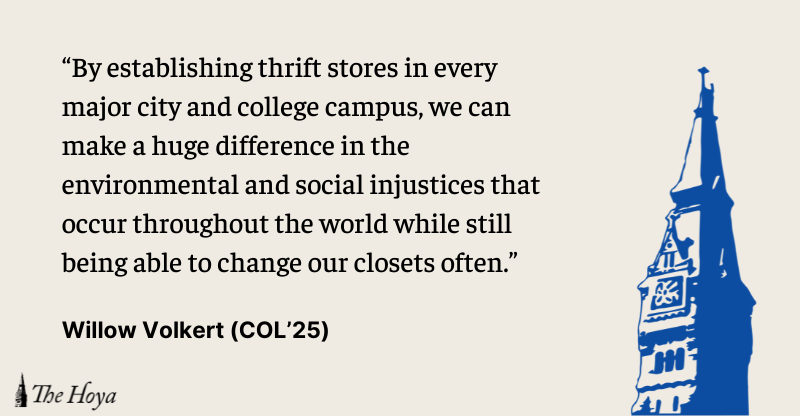As spring cleaning season approaches, it’s time to talk about clothing waste. I’m sure we’ve all thrown away plenty of clothes in the past, in a bout of wardrobe panic and worry over whether we have enough clothes or if they’re “trendy” enough. Although many of us donate old clothes we don’t want, many of these donations still make their way to landfills because of their low quality or because thrift stores like Goodwill are overwhelmed with excess clothing.
Due to our obsession with new clothing, the United States produces approximately 13 million tons of textile waste each year while global consumers throw away approximately 92 million tons of textiles. The fashion industry also accounts for 10% of global carbon emissions, creating a vast and extreme environmental footprint.
Material waste results from the lack of regulation on textile production and the cultural mindset of having to stay “in style,” which encourages fast clothing turnover and contributes to increased waste. This excess demand for new clothes culminates in severe natural pollution and horrible working environments for factory workers employed by fast fashion corporations like H&M and SHEIN. To prevent these effects from worsening, consumers must look towards circular clothing economies and adopt habits like thrifting to decrease and prevent future textile waste.
Understanding the wide ranging impact of the fashion industry provides a fuller picture of the harm textile waste causes. Aside from large amounts of waste and high carbon emissions, textile production also sucks up 93 billion metric tons of water each year — cotton production alone requires 7,500 to 10,000 liters of water per kilogram. Cotton production also calls for pesticides and fertilizer, which pollute water sources and cause eutrophication, the over-fertilization of a water source, leading to algal blooms that deplete oxygen and suffocate other species in the water.
Moreover, polyester and other synthetic materials such as nylon and spandex shed microplastics into wastewater when washed. These microplastics then either flow into water sources leading to the ocean or into wastewater treatment plants, where the finished sludge is used as fertilizer and microplastics enter the soil and food chain. Accordingly, an estimated 35% of microplastics in the ocean come from fashion corporations, which kills marine life through ingestion and contributes to the Great Pacific Garbage Patch.
In addition, global fashion corporations have moved their factories from countries with stricter environmental regulations to those with few or no environmental or labor laws. Under these conditions, corporations pour carbon dioxide and toxic pollutants into the atmosphere and water sources with little to no punity.
Meanwhile, factory workers are overworked, underpaid and constantly subjected to hazardous conditions. Less than 2% of all fashion workers make a living wage, and many are underage. In 2013, an eight-story building in Bangladesh collapsed, killing 1,138 garment workers. The Rana Plaza collapse is a perfect example of how global fashion corporations avoid addressing infrastructure problems to maximize profit.
All of these horrendous environmental and social injustices are perpetuated by our consumer culture. Growing up in a developed country, we are conditioned to buy new clothes every 2-3 months in order to stay on top of the latest and coolest trends. This is a consequence of the colonial and capitalist mindset of “profit above all else.” Corporations inundate consumers with advertisements, convincing them to continue purchasing beyond what they need despite harmful consequences.
Government regulations can hold corporations accountable for unsustainable practices, but the best way to change fast fashion practices is to make people aware of the consequences of buying new clothes all the time. By publicizing websites like the app GoodOnYou that expose the external costs associated with overconsumption, such as environmental damage and inhumane treatment of workers, we can shift the narrative new clothes hold.
Furthermore, circular clothing industries like thrift stores are more sustainable and cost effective and should replace the current extractive and unsustainable fashion industry. By establishing thrift stores in every major city and college campus, we can make a huge difference in the environmental and social injustices that occur throughout the world while still being able to change our closet often. Recently, here at Georgetown University, Georgetown Renewable Energy and Environmental Network (GREEN) has partnered with The Corp to create Uncommon Threads, a small thrift store inside of Uncommon Grounds to reduce textile waste on campus and support GU Mutual Aid by donating the profits. By moving to only purchasing thrifted items, we can support the building of a circular economy around the world and help to right environmental and social injustices.
Willow Volkert is a first-year in the College.









